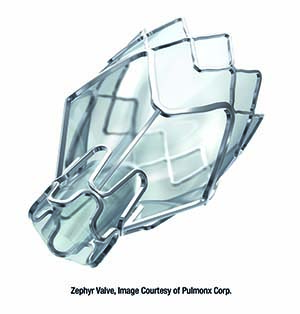Experience The Blessing Difference: Bronchoscopic Lung Volume Reduction
Brochoscopic lung volume reduction or BLVR, is a minimally invasive procedure performed by our pulmonologist, that uses a bronchoscope to place one-way endobronchial valves into the airways of patients with COPD / emphysema.
What is an endobronchial valve and how is it used in treatment?
An endobronchial valve is an implanted device designed to fit in the airways of the lungs. The valves are placed in selected airways during a bronchoscopy procedure, meaning no incisions or cutting is required, and are an alternative to the more invasive traditional lung volume reduction surgery.
Who would benefit from a bronchoscopic lung volume reduction?
Generally, ideal candidates for BLVRs are patients who:
- Have a confirmed diagnosis of emphysema and/or COPD
- Have to stop to catch their breath often, even with taking their medication as directed
- Have reduced lung function
 These are general criteria but only a trained physician can determine if you are a candidate. If you do not already see a Pulmonologist, click here to request an appointment.
These are general criteria but only a trained physician can determine if you are a candidate. If you do not already see a Pulmonologist, click here to request an appointment.
What are the benefits of an endobronchial valve?
Studies have shown patients treated with endobronchial valves have been shown to:
- Breathe easier
- Be more active
- Enjoy an improved quality of life
How does the Procedure Work?
If you have severe COPD/emphysema you may struggle to catch your breath while doing everyday tasks. This is because the damaged parts of your lungs have lost their ability to release trapped air and have become overinflated. The valves stop air from entering the diseases part of the lungs and allow trapped air to escape. This allows the healthy areas of the lungs to expand and function better, which help minimize shortness of breath. The valves are designed to be permanent, but they can be removed any time.

What can Patients Expect?
Endobronchial valves are placed during a procedure that does not require any cutting or incisions. A typical endobronchial valve procedure looks like this:
- Step 1: While no cutting or incisions are needed, the bronchoscopic lung volume reduction procedure is performed under general anesthesia.
- Step 2: During the procedure, a small tube with a camera, called a bronchoscope, will be inserted into the lungs through the mouth.
- Step 3: During the procedure your doctor will place on average 4 endobronchial valves in the airways. The number of valves placed will depend on the individual anatomy of each patient’s airways.
- Step 4: Most patients will stay in the hospital for at least 3 nights. Some patients who experience a complication may be required to stay longer.
- Step 5: After the procedure, you will continue to use the medicines that your doctor has prescribed for your condition.

Think You’re a Candidate?
Contact our Pulmonology department at (217) 214-2670 or click here to request an appointment.

